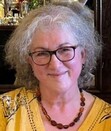Debbie Young's Blog, page 4
November 24, 2024
Of House and Home
Although it’s always sad to lose local shops and services, there’s something very charming about living in a house that once served a commercial purpose.
Hawkesbury Upton is full of characterful homes wrought from former pubs (so many pubs!), stores, workshops, and even places of worship. As you may know, my cottage is among them, as a former village post office – not to be confused with The Old Post Office just up the road. We never do anything by halves in Hawkesbury Upton.
With the sympathetic conversion of the Methodist Chapel into accommodation well under way, the trend is set to continue. Time will tell whether The Fox* will follow suit.
Where Hawkesbury leads, London follows …
According to Emanuele Midolo of The Times (11 October 2024), thanks to Covid normalising working from home, there are enough empty offices in our capital to provide space for 60,000 flats. These urban workplace conversions will be nowhere near as pretty as those in our village, but I bet they have better mobile signals. Oh, and buses and trains and the Tube and taxis …
Repurposing old commercial premises has always been a great way to supply much-needed housing stock. I’m therefore surprised as I drive about the country to come across the odd shop that clearly closed down years ago, but still retains all its stock, beneath the gathering dust.
These retail equivalents of the Marie Celeste fascinate me.
Are they a benign front for secret drug dens? Is the proprietor lying dead, undetected, behind the counter? Or can they simply not get the staff? I want to know their back stories.
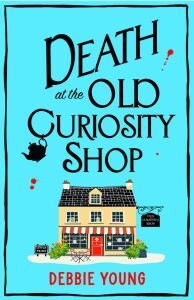 Spotting such shops inspired my latest murder mystery novel, Death at the Old Curiosity Shop. In this story, Alice Carroll (50), moves to the Cotswold village of Little Pride, intending to turn a derelict bric-a-brac shop into a trendy cottage-core home. Only after moving in, she discovers she’s obliged by local planning regulations to keep the shop open for business. Mayhem ensues – as does the obligatory dead body – and Alice must turn amateur sleuth to save her shop, her reputation and her freedom. Death at the Old Curiosity Shop is now available to order online, from local bookstores and libraries, and – of course – from Hawkesbury Stores. Long live our remaining village shops!
Spotting such shops inspired my latest murder mystery novel, Death at the Old Curiosity Shop. In this story, Alice Carroll (50), moves to the Cotswold village of Little Pride, intending to turn a derelict bric-a-brac shop into a trendy cottage-core home. Only after moving in, she discovers she’s obliged by local planning regulations to keep the shop open for business. Mayhem ensues – as does the obligatory dead body – and Alice must turn amateur sleuth to save her shop, her reputation and her freedom. Death at the Old Curiosity Shop is now available to order online, from local bookstores and libraries, and – of course – from Hawkesbury Stores. Long live our remaining village shops!
*Since I wrote this article for the November issue of the Hawkesbury Parish News, it’s been announced that The Fox has now been bought by a local business who will be reopening it again as a pub with rooms. Hurrah!
IN OTHER NEWS
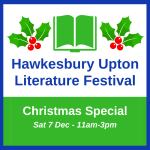 Hawkesbury Upton Literature Festival Christmas Special – Saturday 7th December (11am-3pm)
Hawkesbury Upton Literature Festival Christmas Special – Saturday 7th December (11am-3pm)
I’m busy preparing for the last HULF event of 2024, a fun day of festive talks and seasonal stories by visiting authors, plus heartwarming readings of traditional Christmas classics.
It’s a great way to get into the Christmas spirit – and to buy lots of easy-to-wrap Christmas presents for your friends and family! All the authors will be happy to sell you signed copies of their books as personalised Christmas presents.
Guest speakers include writers Linda Alvis, Carole Britton, Lucienne Boyce, Jean Burnett, Frances Evesham, Tiggy Greenwood, John Ruthven, Mark Rutterford, Betty Salthouse, and me.
Lucienne, Jean and Mark will be reading seasonal stories written especially for this event – we’re very honoured!Gerard Boyce will perform some classic Christmas poetry and prose.Linda Cohen, founder and director of Read With Me, will also join us to tell us about the great work of this Gloucestershire children’s charity at Christmastime.The £5 ticket includes tea, coffee, and cake, plus a £2 book token valid on the day. During the lunch break, home-made soup and rolls will be for sale in return for a donation to the Gloucestershire children’s reading charity, Read With Me.
Please note: this event will take place at Hawkesbury Village Hall this year, because our usual winter setting of the Bethesda Chapel is currently being refurbished. We hope to return there in the spring, then to St Mary’s Hawkesbury in September.
BOOK YOUR TICKETS VIA EVENTBRITE HERE
Advance booking is essential to make sure we have enough cake and soup to go around!
November 14, 2024
The Power of the Streak
Day 185 of my Duolingo Latin streak, and the little green owl, Duo, mascot of this popular language learning app, has just emailed me to say he sees a 186-day streak in my future.
He’s right. The concept of the streak plays a huge part in Duolingo’s success. Once you get going, you dare not miss a day of practice for fear of cutting your streak short, although if you practise a lot, you’ll earn a Streak Freeze allowing you to take a very occasional day off. The longer the streak, the harder it is to lapse, especially when Duo is constantly stalking you with reminders.
If the green owl graphic wasn’t so cute, he’d seem positively sinister.
This is the second time I’ve built up a long Duolingo Latin Streak. Over the years, I’ve spent so many hours with Duo that I’ve completed the Latin course several times over. However, it’s far from comprehensive. I know I’d learn much more if I spent the same amount of time studying the Cambridge Latin Course. I first came across this course at secondary school, and the course book is currently Amazon’s bestseller in Latin. Even so, I can’t seem to escape Duo’s clutches.
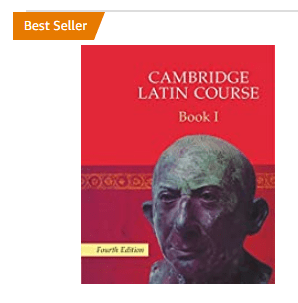 I was astonished to find my old school Latin textbook is currently a bestseller on Amazon – bestseller n the Latin category, anyway!
I was astonished to find my old school Latin textbook is currently a bestseller on Amazon – bestseller n the Latin category, anyway!We all know that apps are designed to be addictive, applying streak mechanisms to keep you hooked. The concept of the streak was around long before the invention of the app. Inevitably at my age, my earliest experience of the grip of the streak is analogue: the yellow attendance card for Scripture Union club at primary school. The A6 card was ruled into neat squares, and each time we attended the after-school club, the kindly Mr Linton stamped a little star into the next blank square. A row of stars earned the cardholder a bookmark, a full card a book. Gaining stars was a powerful motivator for attendance, as was Mr Linton’s obvious pleasure at our progress.
Perhaps I should apply the same psychology to housework, never high on my list of priorities.
 I need my own Duolingo as my personal cheerleader for housework
I need my own Duolingo as my personal cheerleader for houseworkI could easily make up a Scripture Union style card and reward myself with a stamp for every completed task. But it wouldn’t feel as fulfilling without the personal endorsement of dear old Mr Linton or Duolingo’s winsome little green owl.
As Mr Linton retired to Norfolk when I was 11, I can’t look to him for help now. Clearly I need my own version of Duo. So, if you come across a small plump green owl with domineering tendencies in need of a good home, please send him my way.
In Other NewsNo sooner is my latest book done than I’m writing the next!
Death at the Old Curiosity Shop was launched last month and has been very well received, with a 4.4* average on Amazon and over 120 reviews and ratings so far. This book is the start in a brand new series, initially planned as a trilogy, set around Alice Carroll, the new proprietor of a derelict bric-a-brac shop in the Cotswold village of Little Pride. I had such fun creating the new setting and characters that as soon as that book was in production, I set to work on the sequel. Death at the Village Chess Club will be launched on 3rd March 2025, and is already available to preorder. I’ll share the cover here as soon as I can.
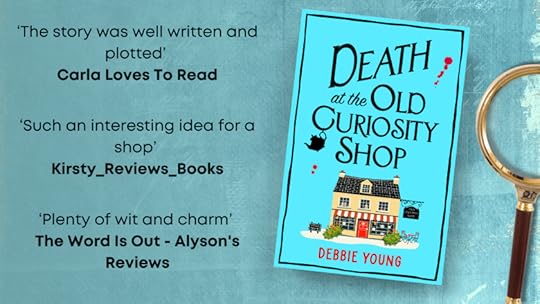 Just some of the kind reviews of my latest book so far
Just some of the kind reviews of my latest book so farIn the meantime, I’m getting in festive mood as I organise the next Hawkesbury Upton Village Literature Festival event – the now traditional Christmas Special. This will include readings of classic favourite Christmas poetry and prose, as well as readings and talks by local authors. Three of the guest speakers will be sharing stories written for this occasion. The Festival is very honoured! For more information and to book tickets, visit the HULF website at www.hulitfest.com, or book your tickets online via Eventbrite here. Advance booking is essential to make sure we’ve got enough refreshments and chairs to go around!
October 30, 2024
In Conversation with Dr Carol Cooper
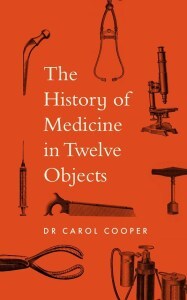 When I heard that my wise, witty and smart author friend Dr Carol Cooper had been commissioned to write a book called A History of Medicine in Twelve Objects, I was impatient to read it. I love any book that makes history more accessible via the lens of a well-chosen list.
When I heard that my wise, witty and smart author friend Dr Carol Cooper had been commissioned to write a book called A History of Medicine in Twelve Objects, I was impatient to read it. I love any book that makes history more accessible via the lens of a well-chosen list.
I first came to know Carol through her compelling novels, two set in London and one in Alexandria, Egypt, where Carol grew up, and we’ve long been members of a wonderful writers’ group called The Sanctuary. Carol has also had a distinguished career in medicine as a practising doctor, as a lecturer, and medical journalist, and is a fellow of Newnham College, Cambridge, her alma mater.
I knew this new book was going to be a great read, so was glad to receive a review copy prior to publication. I couldn’t put it down.
It’s the sort of book where you find yourself reading aloud fascinating snippets to whoever else is in the room.
In accessible, easy-to-read style, Carol describes the stories behind the invention of the titular twelve objects and how they each revolutionised a branch of medicine. She also includes fascinating anecdotes about the characters involved along the way, including patients as well as the pioneers behind the inventions.
Available in hardback, ebook, and audiobook narrated by Carol, The History of Medicine in Twelve Objects would make an excellent Christmas present for anyone interested in public health and medical matters, and for readers who enjoy popular science books.
I’m very pleased to welcome to join us on my blog today to share more insights into her new book.
Debbie: Carol, you were commissioned to write this book when your publishers identified a gap in the market for a history of medicine viewed through a number of key objects. What made you the perfect person to write it?
Carol: It was an idea that my agent and I had tossed around. While I loved the concept, I wasn’t that keen to write the book at first because I was engrossed in drafting a novel. But as you see I gradually came round to it. Why me? Well, I’m not a historian, but I do sometimes feel like a relic from days of old. I’ve been a doctor for many years, worked in several different major specialities including orthopaedics and chest surgery, and seen many changes over time. I suspect it was my long experience of medicine along with an almost equally long career as a journalist and author that helped convince publishers.
Debbie: For a while now there has been a vogue for viewing particular aspects of the human experience through the prism of a list, eg Neil MacGregor’s A History of the World in 100 Objects. Was the number twelve imposed on you or did you choose the quantity – and if the latter, what were your criteria for choosing them?
Carol: You can see the appeal of those lists. Each of my objects tells a story. It speaks of the ingenuity applied to solve a problem, which in many cases is a life-or-death situation. Objects come from a particular time, and may be typical of a certain culture. Ten was the number that my agent first had in mind, but I thought it would be impossible to cover the range of medicine in just ten objects, so we stretched it to twelve.
I could have chosen thirty or fifty, but I wanted to delve into the lives of the trailblazers and their patients, not just describe the tools.
I selected objects that were developed primarily for treating people, a criterion that excluded such things as thermometers. Each one also had to be important in helping to develop a particular speciality or, as in the case of the microscope, for instance, to lead to discoveries that completely changed medicine. While the chapters chart a progression over the centuries, you could read each one on its own, or in a different order.
Debbie: Of course it’s really far more than 12 objects because in each section you elaborate on various iterations of a particular item over the centuries, and in some cases across millennia. Do you have a personal favourite chapter or object?
Carol: I love the heart-lung machine. It goes back to the early 1950s, so I never knew a time when it didn’t exist. But, when I was a junior doctor at Harefield Hospital, Northwest London, I learned about the era before cardiac bypass, when surgeons could only attempt open-heart surgery by reducing the patient’s metabolism.
That’s because the brain can only last four minutes without oxygen-rich blood, which, as you can imagine, severely limits what surgeons can do.
Thomas Holmes Sellors and his team at Harefield made use of hypothermia. They literally dunked their patients into an ice-cold bath to bring down their core temperature and reduce their metabolic need for oxygen. And that enabled daring new operations that gave new life to blue babies and others with congenital heart disease. Many of these conditions can now be totally corrected with the help of the heart-lung machine, along with the appropriate expertise.
When I worked at Harefield, wards were full of children from all over the world with various types of cardiac problems that would have been lethal only a short time before.
As I recount in the book, the heart-lung machine was the pipedream of a young doctor called John Gibbon at Massachusetts General Hospital. It was 1931 and he was at the bedside of a desperately ill patient for whom he could do nothing, other than sit with her through the night and watch her die. What if, he wondered… That patient died, but twenty years later Gibbon and his wife Mary, who was also a scientist, had developed his madcap idea into a workable heart-lung machine.
Debbie: Which of the 12 objects has saved the most lives or had the biggest impact on the welfare of mankind?
Carol: That’s a tough question. The humble hypodermic is essential to modern healthcare, but I think my answer would be either the microscope or the X-ray machine. The microscope brought with it the germ theory of infection. Without it, we might still be clinging to wrong-headed notions about disease, like the “four humours” that so convinced Hippocrates and Galen.
The microscope led to vaccines, antibiotics, and accurate ways to study tissues (for instance, in a sample taken at biopsy).The X-ray machine has revolutionised both diagnosis and treatment by allowing doctors to see inside the body without relying on guesswork, or operating to take a look, or waiting for the post-mortem.Even today, many parts of the world don’t have access to X-rays and other imaging procedures.
An invention in itself doesn’t save lives. It has no value unless it’s made available to those that need it.
Debbie: You’ve gone into tremendous and fascinating detail. (It would make a great source book for the “Elves” who research the TV programme QI!) How did you go about the necessary research and how long did it take you?
Carol: I’ve no real idea how long it took because I enjoyed it so much. But I can tell you that I had around nine months to write the book and I spent a lot of it in Cambridge’s splendid University Library which holds a copy of every book ever published, along with most of the journals. I was also privileged to use the library in my own college. As well as having delightful buildings and gardens, Newnham has one of the best-stocked college libraries in the university. As a women’s college, it always had to. For a long time, women students at Cambridge were barred from using the university’s facilities.
Debbie: What surprised you the most among the facts you uncovered?
Carol: One surprise was that, sometimes, the person I’d always thought had made a particular discovery was not, in fact, the first to do so. I’ve included several examples of this, for instance, in the chapter on X-rays. Writing up one’s work is a good way of establishing priority of discovery, hence the saying “Publish or perish,” but there’s often more to it.
The person that posterity celebrates is sometimes the more prominent person, or the more academic, or the one with friends in high places.
There’s also that other well-known saying: “It’s not what you know, it’s who you know.”
Debbie: It’s much more than a history through objects, because these objects didn’t spontaneously generate – they are the result of the tremendous inventiveness, imagination and perseverance of bold, extraordinary thinkers. Many of these were also incredibly brave, first testing their theories and creations on themselves. If you could give your own version of the Nobel Prize for Medicine to the most remarkable of these pioneers from down the centuries, which would you choose, and why?
Carol: The first Nobel prizes were awarded in 1901, so there are many innovators who missed out on a laureate because they were born too soon. That makes it hard to choose just one to honour, but I think I would nominate French doctor René Laennec who invented the stethoscope in 1821.
The normal way of listening to a patient’s chest in those days was to put one’s ear directly onto the chest. One particular day, however, Laennec’s patient was a curvaceous young woman. It was awkward. On the spur of the moment, he picked up a notebook, rolled it up, and used it as a tube to listen to his patient’s chest.
This serendipitous invention led to a more scientific approach to medicine, especially diseases of the chest like TB. Laennec studied all the different sounds that could be heard with a stethoscope, and correlated them with symptoms. He then published his work in a massive tome that became a classic. Less well-known is the fact that Laennec listened to his patients as they told him of their worries.
He was a true scientist, but he was also patient-centred, and I think he deserves the highest accolade.
Debbie: Fast forward to the 21st century, and are there still opportunities for individuals to make a huge difference like a modern-day Pasteur, for example, or are we now in the hands of big pharma and capitalist businesses bent on profit rather than the common good? (Many of the pioneers you describe made very little money from their inventions.)
Carol: I think there are still lateral thinkers who will come up with valuable ideas, but we live in a different world.
Nowadays any new advance has to be evidence-based, so the clinical trial is king.
And that’s often expensive. These days more than ever, an innovator needs backers to supply necessary funds for trials, and then, if those are successful, to help their ideas gain traction.
Debbie: You also write novels, each with a medical element – can you please tell us a little about each of your works of fiction.
Carol: My first two novels are contemporary stories set in London. In One Night at the Jacaranda, the characters are looking for someone special, and each one of them is lying. For instance, the ex-con conceals his stretch inside, the charity worker keeps quiet about his terminal cancer diagnosis, and the GP lies about his job because he’s sick of people telling him their symptoms. It’s light in tone, but the serious point is that you can’t build a relationship on a foundation of lies.
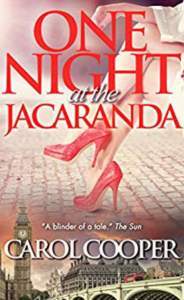
Hampstead Fever continues the story for some of the characters and introduces new ones as they grapple with work, children, ageing relatives, and the other challenges life throws at them.
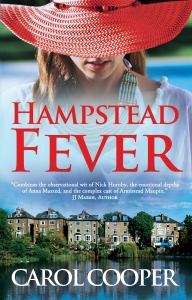
The Girls from Alexandria is different in that it takes place mainly in Egypt, where I grew up, and much of the action goes back to the glamorous fifties and sixties. The main character is seventy-year-old Nadia who’s losing her mind. If she doesn’t find her sister, who is her one surviving relative, she will end up in a care home. The snag is that Nadia’s sister disappeared some fifty years ago, and nobody believes she even existed.
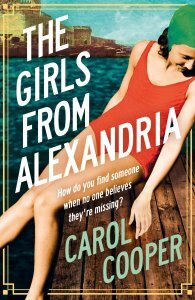
All my novels are multicultural and have a medical thread running through them – there are sick children, stressed doctors, confused seniors, and a number of medical conditions even if they’re not always the main thrust of the story. I believe that writing what you know makes a story more authentic and more believable.
Debbie: Carol, thank you so much for taking the time to join us here on my blog today. It’s been an absolute pleasure, and may The History of Medicine in Twelve Objects be a Christmas bestseller!
More About Dr Carol Cooper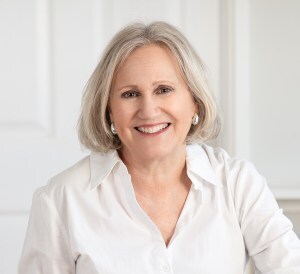 Dr Carol Cooper is a doctor, journalist, and author. She taught students at Imperial College Medical School for almost twenty years, for which she received the Outstanding Contribution to Teaching Award in 2022. She was elected President of the Guild of Health Writers in 2014, and is a Fellow of Newnham College, Cambridge, her alma mater. Carol has authored and edited a string of non-fiction books on health and medicine, including an award-winning book on general practice. She also writes novels with a medical strand. Best of all, she has three amazing sons.
Dr Carol Cooper is a doctor, journalist, and author. She taught students at Imperial College Medical School for almost twenty years, for which she received the Outstanding Contribution to Teaching Award in 2022. She was elected President of the Guild of Health Writers in 2014, and is a Fellow of Newnham College, Cambridge, her alma mater. Carol has authored and edited a string of non-fiction books on health and medicine, including an award-winning book on general practice. She also writes novels with a medical strand. Best of all, she has three amazing sons.
Follow Carol on her website at www.drcarolcooper.com and on Instagram at @drcarolcooper, where she often shares fascinating facts related to her books and her writing life.
October 24, 2024
In Praise of Old Technology
The recent gift of a vintage portable manual typewriter from kind friends set me reminiscing about old technology and, as the world wearies of constant connection to the internet, its place in our future.
I use a computer keyboard every day, but it’s been decades since I used a manual typewriter keyboard. Typing my first letter on my little machine jogged my memory about forgotten differences between keyboards ancient and modern.
Depressing the typewriter’s keys requires a much more forceful action than a computer keyboard, because you must physically force the little metal letters to rise from the type basket (the arc of letters in front of the paper) and hit the page, their shape imprinted via the inked ribbon.
 The typebasket
The typebasketThe choice of font is restricted to one style and size, specified by the manufacturer. Not until electric typewriters were invented, where the letters sat on a rotating “golf ball”, could the user vary the font, and only then by removing and replacing one golf ball with another.
 The ‘golf ball’ – a little revolving globe covered in letters – is concealed beneath the IBM logo in this machine
The ‘golf ball’ – a little revolving globe covered in letters – is concealed beneath the IBM logo in this machineThe choice of characters is much smaller too.
No emojis here.
In fact, there’s not even an exclamation mark on the compact keyboard of my portable typewriter. Instead, you have to type a full stop, then backspace, then add an apostrophe above it. When I showed my Gen Z daughter, she was perplexed. How could it be possible to place two characters in the same space on the line? On the computer keyboards that she’s grown up with, backspaces are destructive, used to erase a typo.
The sound of a manual typewriter’s keyboard is entirely different to a computer’s. The sound of the little metal keys hitting the page is followed by the distinctive “ping” as you near the end of a line, warning you to return the carriage (the roller holding the paper) to start a new line. To me, these sounds are pleasantly nostalgic. Not so for my daughter.
Taking a phone call while I typed a letter, she told her caller, “I’ll have to take this in the other room – Mum’s making a noise with her typewriter.”
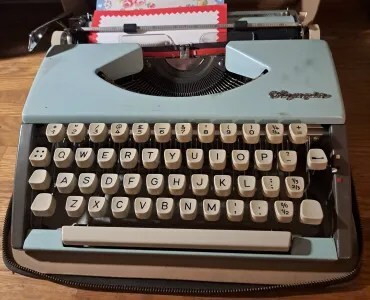 Noisy, but fun
Noisy, but funThere are lots of reasons I think manual typewriters deserve to make the comeback currently enjoyed by vinyl LPs and audio cassette tapes.
While typing on a typewriter, you can’t be distracted by people sending you messages.Nor can you distract yourself by surfing the internet.Neither can you be hacked.Rumour has it that the KGB bought typewriters a few years ago to make sure messages stayed secret. Enigma machine it ain’t, but I can see the appeal of the manual typewriter to anyone sensitive about safeguarding privacy.
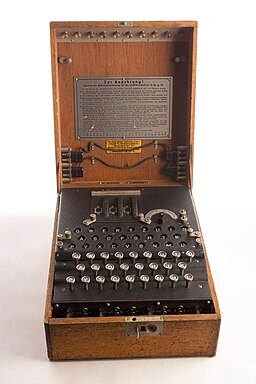 The Enigma Machine for breaking coded German military messages, credited with shortening World War II and saving at least 14 million lives
The Enigma Machine for breaking coded German military messages, credited with shortening World War II and saving at least 14 million lives
So, what will be the next piece of old technology to be revived for entirely twenty-first century reasons? My money’s on implements for writing by hand. Irked by the wastefulness of disposable, short-lived plastic ballpoint pens and by tree-slaying pencils always blunt or broken when you need them, I wonder whether I can start a movement for the return of the quill pen, surely the most environmentally-friendly and compostable writing device ever invented. Now I just need to find a cooperative goose…
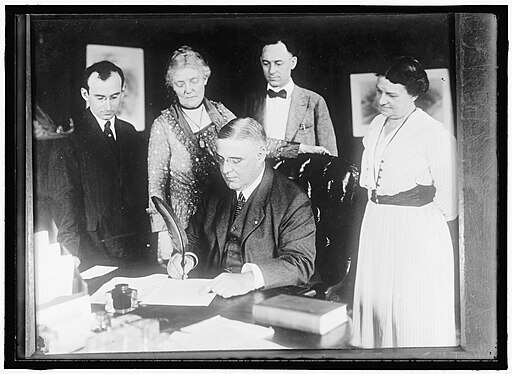 When only a quill pen will do: the Governor of Pennsylvania signing the Suffrage Amendment
When only a quill pen will do: the Governor of Pennsylvania signing the Suffrage AmendmentThis post was written for the October 2024 issue of the Hawkesbury Parish News.
IN OTHER NEWS
My latest cosy mystery novel, Death at the Old Curiosity Shop, has now finished its blog tour, and I’m delighted by the many lovely things that bookbloggers have been saying about it.
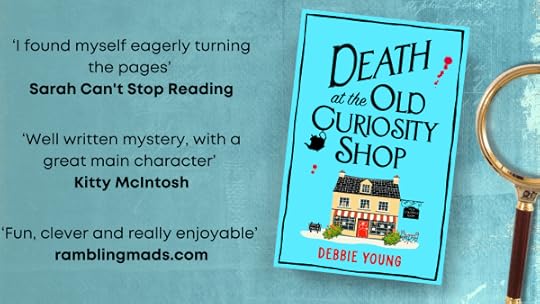 Order your copy from your local bookshop or library or online (click image for Amazon buying link).
Order your copy from your local bookshop or library or online (click image for Amazon buying link).In the meantime, Boldwood Books has announced the publication date for the second in this new Cotswold Curiosity Shop series: 3rd March 2025. It’s already available for pre-order on Amazon here as an ebook, and on the launch date will be available as an ebook on other platforms too, and as a paperback, hardcover and audiobook. You’ll have to wait a little bit longer for the title and cover!
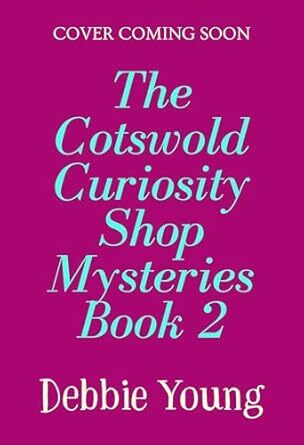 The title’s coming soon, as well as the cover…
The title’s coming soon, as well as the cover…And there’s never an idle moment for me, because as soon as I’ve processed my editor’s comments on this second book, I’ll be starting to write the third. It’s all happening for Alice Carroll!
Meanwhile I’m looking forward to hosting the third Hawkesbury Upton Literature Festival Christmas Special on Saturday 7th December, here in my home village. It’s a celebration of festive books of all kinds, and will include:
performances of seasonal short stories written especially for the occasionreadings of classic Christmas poetry and prosetalks by local authors about their festive booksOur special festive guests will include:
thriller writer AA Abbottchildren’s author Linda Alvistravel writer Steve Berryhistorical novelist Jean Burnetthistorical novelist and historian Lucienne Boycevoice artist Gerard BoyceLinda Cohen, CEO of local children’s charity Read With Memystery writer Frances Eveshamchildren’s author Tiggy Greenwoodromantic novelist Stefania Hartleytravel writer/biographer Carole Mitchelldocumentary maker John Ruthvenshort story writer Mark Rutterfordchildren’s author Betty Salthouse and me!Advance booking is essential as space is limited and the price of £5 (plus small booking fee), including tea and cake and a £2 book voucher, is such a bargain that we’re sure to sell out!
October 16, 2024
Never Too Late to Learn – PLUS New Book Out Now: “Death at the Old Curiosity Shop”
Don’t we all have a skill we yearn to learn but have never quite got round to mastering?
When I entered the job market post-university, one of the first things I did was to learn to touch-type. That skill has been a boon in every job I’ve ever had, using every generation of technology from the electric typewriter to the electronic tablet.
Aiming for a job in journalism, I also planned to acquire a decent shorthand speed. Instead, I got no further than buying a Teach-Yourself Pitman’s book before landing my first full-time job.
 Optimistically, I also bought a copy of a Sherlock Holmes novel entirely in Pitman’s shorthand
Optimistically, I also bought a copy of a Sherlock Holmes novel entirely in Pitman’s shorthandLucky to be in constant employment from then on, my shorthand book gathered dust for many years until, working as news editor for a trade magazine, I decided I didn’t need to learn shorthand after all. Instead, I gained the knack of writing longhand very fast, joining letters in unusual ways to speed the pen across the page. My once-neat handwriting became a scrawl, but it worked for me.
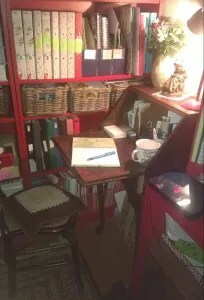 Ironically, I still write the first drafts of my novels by hand
Ironically, I still write the first drafts of my novels by handExpecting the rise of digital voice recording to have rendered shorthand obsolete, I was surprised to discover recently that it still flourishes in certain quarters.
Shorthand is essential for court reporters, for example, because voice recorders are not allowed in court.
At my age, I don’t plan to become a court reporter (though I’m longing to be picked for jury duty out of pure curiosity). Nor do I need to write secrets in a code illegible to others, as Pepys did in his diary.
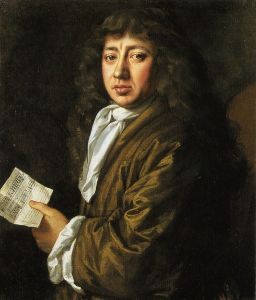 Now that’s confusing – in this portrait, Samuel Pepys appears to be holding a piece of music (Portait by John Hayls, Public Domain, via Wikipedia)
Now that’s confusing – in this portrait, Samuel Pepys appears to be holding a piece of music (Portait by John Hayls, Public Domain, via Wikipedia)So why does the idea of learning shorthand still appeal to me? As Mallory said when asked why he wanted to climb Everest, it’s simply because it’s there. Of our two challenges, I’ve certainly picked the easier.
Also, we’re constantly told that learning new skills keeps our brains young. While I’ve worked hard to maintain a lengthy Duolingo streak in Latin, shorthand will be more useful in daily life. My first Teeline instruction book is now on order.
Like Mallory’s ill-fated ascent a century ago, my journey will start with this single step. Thankfully, my adventure is less likely to make me disappear without trace.
This post first appeared in the October 2024 edition of the Tetbury Advertiser.
In Other NewsOut Now: Death at the Old Curiosity Shop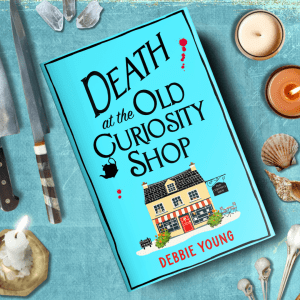 Order now at your local bookshop or library, via your favourite online retailer, or click the image to buy from Amazon.
Order now at your local bookshop or library, via your favourite online retailer, or click the image to buy from Amazon.My fourteenth cosy mystery novel is now available in ebook, paperback, hardback, and audiobook, from wherever you prefer to buy books. Order here via Amazon, search your favourite online retailer, or ask for it at your local bookshop or library.
Death at the Old Curiosity Shop is the first in a brand-new series set in the Cotswold village of Little Pride. When Alice Carroll (50) loses her long-term partner and her job at the city museum, she plans to start a new life in the country, turning a derelict bric-a-brac shop into a cosy cottage-core home. But in Little Pride, nothing is quite what it seems, including her new home.
When she discovers that planning regulations require her to keep the shop trading, the villagers rally round to help her. Then one of her customers is found dead, and the race is on for Alice to save her shop, her reputation and her freedom. With a lively cast of characters to help – or hinder – her quest for the truth, this is a fast-paced, funny, feel-good read, with a touch of gentle romance.
As with every book in this new series, the mystery revolves around an item stocked in Alice’s Curiosity Shop.
Published last Friday, Death at the Old Curiosity Shop is already attracting excellent reviews from book bloggers such as:
“Well-written with a fantastic protagonist” – @StoriedConvo
“Plenty of wit and charm” – Alyson Read
“Fun, clever and really enjoyable” – @RamblingMands
The sequel, which I’ve already written, will follow on 3rd March. Title and cover to follow soon!
And Finally … Meet Alice Carroll!No sooner was the book published, than Alice was “interviewed” by bookblogger Dru Ann of Dru’s Book Ramblings. She runs a fascinating blog in which fictional characters describe a typical day in their life. Read her interview here, where Alice also introduces some of her new friends and neighbours.
September 27, 2024
In Conversation with Brad Borkan and David Hirzel About the Art of Co-Authoring
Today I’m pleased to welcome not one but two guest authors to my “In Conversation” series. Decision science expert Brad Borkan and maritime historian David Hirzel are going to tell us about their collaboration as authors of inspiring history books about decision-making, including their most recent title, appropriately enough It Takes Two or Three – The Superpower of Small Teams.
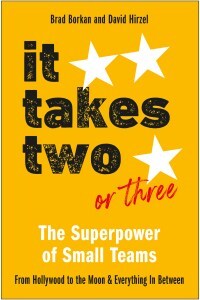 I first met Brad Borkan, an American living in London, back in 2017, not long after he and David Hirzel, based in the USA, after they’d launched their first book, When Your Life Depends On It: Decision-Making Lessons from the Antarctic. I was immediately attracted to the premise, drawing on the experience of early twentieth-century polar explorers, and I devoured the book.
I first met Brad Borkan, an American living in London, back in 2017, not long after he and David Hirzel, based in the USA, after they’d launched their first book, When Your Life Depends On It: Decision-Making Lessons from the Antarctic. I was immediately attracted to the premise, drawing on the experience of early twentieth-century polar explorers, and I devoured the book.
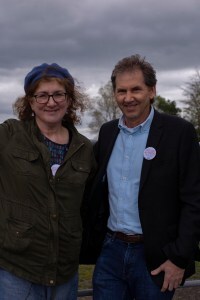 The gloomy weather didn’t spoil our fun at the 2018 Hawkesbury Upton Literature Festival (Photo by Angela Fitch Photography)
The gloomy weather didn’t spoil our fun at the 2018 Hawkesbury Upton Literature Festival (Photo by Angela Fitch Photography)When I eventually met Brad in person, possibly at the London Book Fair, I knew he’d be an articulate and engaging speaker at my Hawkesbury Upton Literature Festival. Even though he’d just been taken on by a public speaking agency planning to hire him out at thousands of pounds on the after-dinner circuit, he generously agreed to be a special guest at our 2018 event. The audience loved him – and he loved the Festival. Talk about win-win!
I’ve followed Brad’s author and speaking career ever since, and I have enjoyed his and David’s two subsequent books too. Having just finished reading their latest, I thought it was about time I invited them onto my blog to share with you the secrets behind their success – and because I was keen to know just how their co-writing partnership works. Here’s our resulting conversation.
Debbie: Brad and Dave, please tell me a little about your background before you became a writer.
Dave: There was never a time before my becoming a writer. I have remnants of little kid-books that I put together in first or second grade, but I started to get serious about it in 1994 when I sat down to write the polar explorer biography trilogy of Tom Crean (that finally all saw print by 2015). To pay the bills, I do residential architectural design here in California.
Brad: Prior to becoming an author, I worked for large software companies. It was a difficult decision to leave the comfort of that to pursue my goal of being a full-time author, but I am glad I did.
Debbie: Please give a short description of the premise of your new book on small teams.
Dave: As we were researching true stories about incredible achievements, we noticed that often some of the most world-changing events came about when two – or at most, three – passionately dedicated minds join forces. The more we investigated this connection, the more we saw this same phenomenon across all realms of human endeavour, hence the title of our newest book: It Takes Two or Three – The Superpower of Small Teams: From Hollywood to the Moon & Everything in Between.
Of the hundreds of teams of two or three that came under consideration, we’ll share just a few here to help you get the idea:
The Wright BrothersGilbert and SullivanLennon and McCartneySusan B. Anthony and Elizabeth Cady Stanton (women’s rights campaigners in the 1800s)Peary and Henson (Arctic explorers)and teams of Apollo astronauts.Debbie: How did you first meet each other?
Brad: We first met at an Antarctic conference in 2015, amusingly called the ‘South Pole-sium’. It was held in a remote part of Scotland where Captain Scott’s grandson lives. To kick off the conference, each person was asked to stand up and explain why they were there. In the audience were esteemed historians, polar adventurers, descendants of the famous polar explorers, collectors of polar books, scientists, authors, and other accomplished people.
Since I was sitting near the front, I was one of the first to speak. I explained that I was fascinated by the decisions the early Antarctic explorers made on the ice and seeking a co-author for a book I envisioned writing. Dave was sitting towards the middle of the room and when it was his turn to speak, he explained he had come to meet old friends and make some new ones, as well as to launch Antarctic Voyager: Tom Crean with Scott’s Discovery Expedition 1901-1904. As I recall, Dave said, “I am interested in what Brad’s interested in – the decision making of the explorers.” I decided to talk with Dave as soon as there was a break.
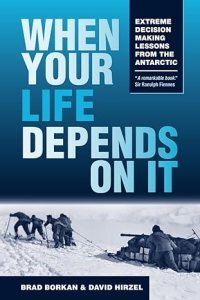 Brad and Dave’s first collaboration
Brad and Dave’s first collaborationDave: Being in between writing projects is a pretty rare occurrence for me, when I heard Brad say he was looking for a co-author to weave together the true stories from the heroic era of Antarctic explorer with the process of decision-making, I thought, I’ve got to meet this guy. So I did, and by the time the conference was over we had agreed to work together, and actually started committing the very first words to paper. Well, to a Word file specifically.
Debbie: Why did you decide to co-write?
Brad: When Dave and I first met at the conference, I explained that to make the book I envisioned successful, I needed to work with an historian who knew more polar history than I did. Dave probably thought I was nuts, but he humoured me. I promised that when I returned to London, I’d email him all of my notes for the book to spark his interest. Dave turned out to be the perfect writing partner.
Dave: It seemed like a great idea for a collaboration. I’d never co-written with anyone, and this seemed like a great opportunity to look at the world through a different lens: decision theory. And make a new friend. Brad’s the idea guy. Also the one with business acumen.
Our process, such as it is, evolved organically around a general idea of trying to share the work equally. The internet makes all this possible, sharing drafts back and forth across the Atlantic.
Debbie: How did you choose the topics and themes of your books?
Brad: There’s an old saying that authors write the books that they wish they could read. That’s true for us. We look at a topic and ask if it thrills us enough to devote years to researching and writing about it.
We have now co-written three books and are currently working on our fourth. As mentioned, the first dealt with the life-and-death decisions the early Antarctic explorers made on the ice, When Your Life Depends on It.
Our second is about three epic achievers: Isambard Kingdom Brunel, Teddy Roosevelt (Panama Canal and National Parks) and Roald Amundsen (first through the Northwest Passage and first to the South Pole). That book is called Audacious Goals, Remarkable Results.
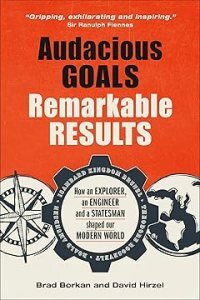
Our newest book, It Takes Two or Three – The Superpower of Small Teams, launched in 2024. Lots of people talk about the importance of teamwork but this is the first book that gives many real historical examples and explains the mindset of the team members.
We decided we were well placed to write this book because even though we are not yet famous, we are a good representation of what we think a small team should be.
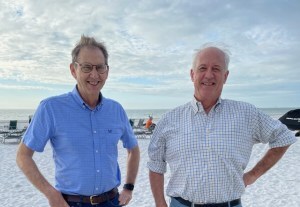 Brad Borkan (left) and Dave Hirzel
Brad Borkan (left) and Dave HirzelDebbie: In It Takes Two or Three, you talk about the defining factors of a fruitful working partnership in small teams – which factors apply to yours?
Dave: Successful partnerships are built on trust and a shared belief that the outcome of any endeavour will be worth the effort put into it. Many of the teams we looked at endured physical and financial hardships that would have intimidated those with less dedication to their goal.
As almost all the examples we cite in our book illustrate, the goal has to be something more meaningful than the acquisition of more money. Our subjects are more interested in solving the unanswered questions of the world:
How can we get the right to vote for women?How can we get home after our ship’s been wrecked?Can you change the way people think through the music that you write?Shared hardships and commitments reinforce each other to strengthen the team’s resolve. Writing a book can be a pretty intimidating goal. In our case, once we have divided up the work, we tend to spur each other on, making commitments to be kept when edited chapter drafts are expected.
Debbie: In your book, the teams you describe are usually working in close proximity, yet you two collaborate from opposite sides of the globe. To what extent is geographical proximity necessary in the age of the internet? What are the pros and cons of working so far apart physically?
Dave: All the teams we studied had to figure out on their own how to get their work done. Physical proximity in Scotland was how we met. On rare occasions (maybe once a year) we can meet up somewhere. We talk on the phone a couple times a month.
Since our books always have an element about polar exploration, Brad in London has access to the many Antarctic resources that abound in England, plus he can keep regular personal contact with many people that I would love to get to know better. So I get a vicarious thrill when he has lunch with, say, Alexandra Shackleton, grand-daughter of the great explorer.
Debbie: Writing a book together is a very specific form of team-working. What are your top tips for any fellow writers who are considering it?
Brad: We recommend two things:
Do not get bogged down in legal agreements. Our theory is that you could spend a fortune on lawyers before you write a word and that could break your partnership before it even gets off the ground. Even today, all we have is a Memo of Understanding. If we ever became wildly successful maybe we’d seek more clarity.For the first 1-3 months focus only on the table of contents. What’s in the book and what’s not. Once that is defined, it will become clear who is best placed to pen the first draft of each chapter.Dave: Probably a good idea to actually know the person you’re taking up a collaboration with. Our example of meeting and diving into the work two days later is not likely to be often repeated. You have to be able to communicate with your partner clearly, and specify your own desires and intentions into a memo of understanding that will codify some of the more critical aspects of working together.
If you’re setting out, like we were, on a collaboration as authors of books, forget about making any meaningful amount of money for your work. Your goal should not be to become rich and famous from your writing work, but to tell the story you have in mind in the best way you possibly can.
Debbie: Fiction writers in particular often co-write at least one book with another author in their genre for marketing purposes – to introduce the other to each other’s audiences – but they’re still relatively few. Is this a valid reason for co-writing, or are such self-interested motives unhelpful?
Dave: Chain retail booksellers like Barnes and Noble have no shortage of new books co-written by a famous author—say, James Patterson or Robert Ludlum—and someone else. To me these are clearly marketing approaches rather than the meeting of two minds to craft a compelling narrative together. But since I don’t read popular fiction, I can’t really critique how artistically or financially successful such harnessing of two otherwise unlikely partners might be.
Brad and I deal with history, with facts. Since we can’t make things up, we rely on the amazing true stories to tell themselves, with a little help from us.
Debbie: Speaking about the practicalities, please describe the process you use to co-write your books. How do you divide the responsibilities and the labour?
Dave: We talk on the phone a couple times a month, kicking ideas around. At the start, we get a general idea of chapter themes and ordering. Twelve chapters (plus introduction, conclusion, front and back matter) seems about right. We each pick six chapters, write them on computer where we live (California and London), share them back and forth using Word, editing as we go until by the end it is no longer clear whose chapter is whose.
Brad manages most of the business matters for our subdivision of Terra Nova Press, an imprint based in Pacifica, California, that I own. Eventually, the book is in something like a final order, and Brad sends it off to eminent historians for fact checking, and then to one or more professional editors we trust, to whip it into shape and make it sound like it was all written by one person. This is an iterative process, and sometimes requires three or four edit cycles before we are satisfied.
We take great care in what our books look like. Since our books include photographs and maps, the book’s interior and cover design are created by one of the UK’s leading book designers. The audiobook follows a slightly different process as described in one of the answers below.
Although we self-publish, we do everything a big publisher would do to create a high quality book filled with the most amazing stories and insights.
We’re happy with the way we’ve set up our work.
Debbie: Does co-writing speed up the writing and production process or slow it down, compared to writing on your own, and how?
Brad: This is a good question and our answer may surprise readers. It does neither. We have only one overriding interest. Making our books as good as possible – ensuring they filled with compelling, fascinating, true stories about epic people like Shackleton, Brunel etc.
We know that together we can produce a far better book than either could do on our own.
Each of our books takes 2-3 years to research and write, but neither of us are working on them full-time since we have other commitments.
Dave: We are not in any hurry. No need to speed things up or slow them down, everything will take whatever it takes. The main thing is to look at your work when you consider it to be done and think, “that’s what I wanted it to do.”
Debbie: What do you know now about co-writing that you wish you’d known when you were starting out?
Brad: That it is the fun of brainstorming ideas with a like-minded person. Though we rarely see each other since Dave is in California and I’m in London, we have fascinating phone calls.
Both of our lives have been enhanced by our co-writing process.
Dave: Since our work together has been so intellectually rewarding, I can’t think of a single thing I wish I’d known about.
Debbie: You cite a wide range of examples of collaborators in your book, and I suspect everyone will have personal favourites. (Mine was the Wright Brothers.) Can you single out one or two that have been particularly inspiring to you in your line of work?
Brad: My inspiration has been the co-author pair Larry Collins and Dominque Lapierre. People may not recognise their names but might know their books. They co-wrote Is Paris Burning?, O Jerusalem!, and Freedom at Midnight. These are some of the best historical, non-fiction books I have ever read.
That was the model I was seeking in our co-author partnership. As for the favorite team in our It Takes Two or Three – The Superpower of Small Teams book, I am in awe of the two American women who championed women’s rights in the 1800s: Susan B. Anthony and Elizabeth Cady Stanton. They persevered in ways that were every bit as exciting as the early explorers seeking the North and South Poles, and Hillary and Tenzing on Everest. Every single right that women have today in the US, UK and elsewhere stems from the work of Susan B. Anthony and Elizabeth Cady Stanton.
Dave: My fascination is with the polar teams. I find it so interesting, that from the moment of their most dynamic shared triumph near, but not at the North Pole, Admiral Peary and Matthew Henson never spoke to each other again. The Antarctic teams – Shackleton and Wild, and Bowers, Wilson, and Cherry-Garrard of the Winter Journey – all shared something truly without parallel, a harmonious working and personal relationship that blossomed in the most forbidding of landscapes.
Debbie: I heard you went to a Hollywood award event because of one of your audiobooks. That sounds exciting. Can you tell us more?
Brad: Yes. The narration of the audiobook of our first book, When Your Life Depends on It: Extreme Decision Making Lessons from the Antarctic, was a finalist in the Voice Arts Awards in the History category. Voice Arts are awards for the spoken word, in the same way the Grammys are for music and Oscars are for movies. The reason our book was chosen was that I focused on finding the absolute perfect voice actor to record our audiobook. I listened to over 100 voices before selecting Dennis Kleinman. He had a deep, rich resonance to his voice that I thought must have matched what the early Antarctic explorers would have sounded like.
To make a long story short, Dennis and I attended the red carpet event at Warner Brothers Studios in Hollywood. (Dave was unable to attend.) The event was hosted by big names including Sigourney Weaver. It was the single most thrilling event of my author career, even though our book lost to Cosmos by Carl Sagan. Dennis has become a great friend and has recorded our other audiobooks.
Debbie: For three books you have co-written, the common theme is remarkable human achievements against the odds. You mention towards the end of book 3 that you have several more joint books in the pipeline. Would you care to expand on these plans to whet readers’ appetites? Are any available to pre-order yet? If so please provide a link.
Brad: We are currently working on a book that focuses on what we have learned from the 10 years of working together. We are looking forward to launching that book in early 2025.
Dave: We have other ideas as well, including differing ways that we can put our minds together and share our ideas to reach a wider public. Books are only a part of that process. The rewards of the partnership are what really counts.
Huge thanks to Brad and Dave for sharing these fascinating insights with us.
If you’d now like to read the books or buy them as gifts (they make great Christmas presents!), visit their website for more information here:



September 23, 2024
Never Too Late to Start Afresh
In this month’s column for the Tetbury Advertiser, I was getting overexcited at the prospect of a fresh start
There will never come a September that doesn’t shout “back to school” at me. Although it’s a long time since I left school, I’ve never lost awareness of the academic year.
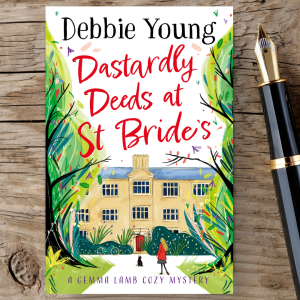 In the first of my St Bride’s cosy mystery series, teacher Gemma Lamb has a fresh start in September
In the first of my St Bride’s cosy mystery series, teacher Gemma Lamb has a fresh start in SeptemberThis isn’t only because supermarkets start badgering parents to shop for the autumn term before the summer holidays even start. Nor it is because I spent thirteen years of my adult life working in a school, or because I write novels set in a boarding school (first in series is Dastardly Deeds at St Bride’s, published by Boldwood Books).
It’s because I look forward to each new term as an opportunity for new beginnings. In September, I even buy an academic year diary to replace the one I bought in January, and which is dog-eared by autumn. I relish starting over with a new diary. Its clean pages inspire me to think afresh about how I spend and manage my time. I’m filled with anticipation and excitement for what the next few months will bring.
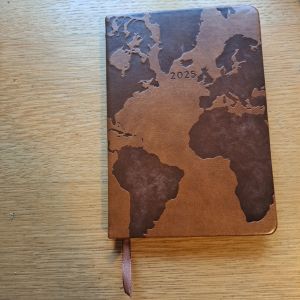 Although it says 2025 on the cover, my new diary actually starts in September 2024 and ends in December 2025
Although it says 2025 on the cover, my new diary actually starts in September 2024 and ends in December 2025Even though the new academic year heralds the coming of autumn, and I hate leaving spring and summer behind, I welcome it all the same. I’m glad our academic year doesn’t run in parallel with the calendar year, starting in January, as it does in Australia. It would give us one less chance for a fresh start.
If my planning goes adrift before Christmas, at least I know it won’t be long until the new calendar year comes around, and I can treat myself to yet another new diary. I’m a diary manufacturer’s dream customer.
Then another season of new beginnings will arrive with the onset of Spring and the symbolism of Easter.
It’s never too late in the year – or in life – to start over. I reinvented myself at the age of 50, leaving the day job to start my writing career.
I’d always planned to be a writer when I grew up, and if 50 doesn’t count as grown-up, I don’t know what does.
So, if you’re at a crossroads in your life, September is the perfect time to start planning for change. By the time you read this, you might even find that this year’s academic diaries are reduced for quick sale, to make way for 2025 stock. Go for it!
Only now as I write this do I realise that living by my system is like having three years rolled into one. No wonder time seems to fly by so fast these days. I’m just glad I don’t age at the same rate.
IN OTHER NEWS
September has been a busy month for me, with four events to speak at, plus another novel to finish writing – the sequel to Death at the Old Curiosity Shop, which will be published by Boldwood Books on 11th October. You can preorder it already via Amazon here and also from other retailers and from public libraries.
Speaking of public libraries, I had a wonderful time on Saturday giving a talk to readers at Yate Library, South Gloucestershire, where the libraries do a brilliant job running a series of local author talks.
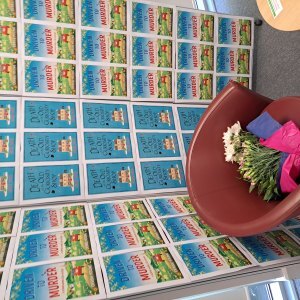 I was touched by how much trouble Yate Library staff had taken to prepare for my talk
I was touched by how much trouble Yate Library staff had taken to prepare for my talkThe previous Saturday, I was plenary speaker at Troubador’s Self-publishing Conference in Leicester, representing Jericho Writers, for whom I teach the twice-yearly Simply Self Publish course, which starts up again in October (more course info here). Here I am congratulating course alumnus Rory Marsden (who writes as R Marsden) on the first four novels in his historical fantasy series. (Sign up for his newsletter here for a free prequel ebook.)
The Saturday before that, I spoke to Writers of Essex, the local chapter of the Society of Authors, about how to set up and run an independent literary festival. Next year we’ll be marking the tenth anniversary of the one I founded – Hawkesbury Upton Literature Festival – so I had plenty of experience to draw on.
One more event to go before the end of the month: on Monday 30th September, I’ll be part of a cosy crime panel at Taunton Literary Festival with fellow authors Frances Evesham and Lionel Ward – more about that event, including the box office, here.
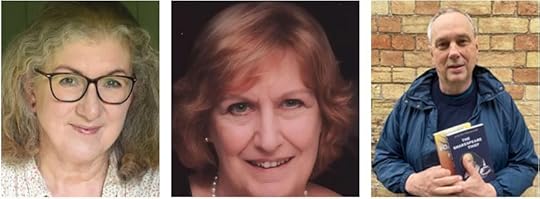 Part of a cosy crime panel with Frances Evesham and Lionel Ward
Part of a cosy crime panel with Frances Evesham and Lionel WardWhich all helps explain why I’m sharing this post on Monday, when I should have published it last Wednesday! Now back to my writing desk…
September 13, 2024
Sanctuary from Summer
How have the intermittent summer heatwaves made you feel? Although more solar-powered souls (and the panels on my roof) may find them energising, I’ve found them exhausting. But I found the perfect cool space for when the heat has got too much: our ancient parish church.
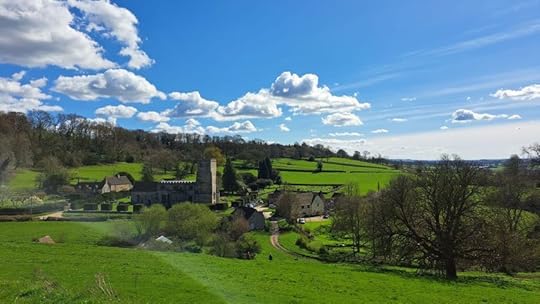 I took this photo from the top of Hawkesbury Knoll at Easter 2023, when the weather felt like high summer!
I took this photo from the top of Hawkesbury Knoll at Easter 2023, when the weather felt like high summer!St Mary the Virgin, Hawkesbury, between the spring and autumn equinoxes for visitors between of 10am and 5pm. Having this year joined the volunteer rota for locking and unlocking the church each day, I’m down there a couple of times most weeks. On really hot days, even first thing in the morning and late afternoon, the difference in climate outside and inside has been remarkable. Leaving the balmy atmosphere of the church reminded me of arriving on holiday in the Mediterranean, feeling the heat hit me like a brick wall as I exited the aeroplane.
The huge interior space and high ceiling of St Mary’s allow plenty of fresh air to circulate, and the thick Cotswold stone walls keep the space cool, despite the tall windows letting in plenty of light. Up in the bell ringing chamber, we ringers realised that pressing ourselves against the stone walls was the perfect way to cool down during energetic practice sessions.
Entering the church in high summer provides a different kind of sanctuary to the two traditional meanings: the area by the altar and the act of seeking refuge from persecution within a sacred space. You don’t need to have faith to benefit.
Although the current climate crisis and its causes are unprecedented, there must have been many summers during St Mary’s 1200-year history that local people have sought its shade. It’s not only as a place of worship that St Mary’s continues to be a valuable resource and a source of comfort to our community.
And not just to humans. At the recent Pets’ Service, to which people brought their pets to be blessed, the many dogs and the one sheep in attendance must have enjoyed the cool atmosphere, as they were all so calm. Or perhaps the Reverend Hilary Cooke, leading the service, was exuding her inner St Francis of Assisi? Either way, the animals were remarkably well-behaved, emitting barely a bark throughout. The sheep contributed a few loud baas, but, like the sound of young visitors playing in the children’s corner, it was a happy sound which made everyone smile.
 Mary brought her sheep
Mary brought her sheepOnly the visiting tortoise appeared not to be enjoying itself, despite cuddles from her owner Hilary Rogers. But at 108 years old (the tortoise, not Hilary!), she could be forgiven for being grumpy. Thinking back now, I’m wondering whether the cool air made her think hibernation time had come early. Like a small child, she might have been protesting against an imminent bedtime before she was done with summer play.
 Hilary took her tortoise to be blessed
Hilary took her tortoise to be blessedTradition, rather than weather forecasters, dictates that the day after the Hawkesbury Show, the last Saturday in August, autumn begins.
Sure enough, as I set up this blog post, there is a fresh, cooler nip in the air and the first hints of autumn colour in the trees. But if by any chance this month brings further heatwaves, and soaring temperatures get too much for you, you know where to go…
PS As the BBC might say, other ancient parish churches are available – so wherever you are reading this, whether at home or away, it’s worth checking out your local one.
This post first appeared in the September issue of the Hawkesbury Parish News – and was written during a heatwave!
In Other NewsI’m having a very busy month, with lots of events in my diary, and in between I’m finishing writing the sequel to Death at the Old Curiosity Shop, which launches on 11th October and is now available to pre-order.
I’m averaging a public event a week in September!
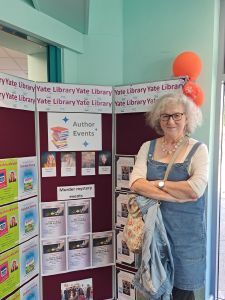 Very pleased to spot Yate Library’s display about my author talk on a recent visit
Very pleased to spot Yate Library’s display about my author talk on a recent visitLast Saturday I gave a talk to the Writers of Essex, on of the Society of Authors‘ official local groups, on How to Set Up and Run a Local Literature Festival. This gave me a great excuse to review the illustrious history of my Hawkesbury Upton Literature Festival, which in 2025 will be ten years old. Time to start planning a special tenth birthday celebration!
Tomorrow (Saturday 14th) I’ll be giving a keynote address at the Troubador Self-publishing Conference – which I’m delighted to see is now sold out – representing Jericho Writers, for whom I’m course tutor for their Simply Self Publish course. Applications are welcome for the October-December course here: https://jerichowriters.com/our-services/courses-mentoring/simply-self-publish-course/Next Saturday (21st September) I’m giving a public talk at Yate Library about my books and my writing life, as part of its busy schedule of author talks – such a brilliant local library! Tickets are just £5 and include coffee and cake. Here’s the booking link: https://www.eventbrite.co.uk/e/coffee-and-cake-with-debbie-young-cosy-crime-author-yate-library-tickets-899191725657Then on Monday 30th September, I’ll be at Taunton Literary Festival, on a cosy crime panel with fellow authors Lionel Ward (also proprietor of the excellent Brendon Books shop in Taunton) and Frances Evesham. Click here for more details of the programme including our event.After all that, you’d think I’d be planning to have a rest on the 1st October – but then the countdown begins to the launch of Death at the Old Curiosity Shop, with a long to-do list in the run-up to the big day.This first in a new series will be available in all formats, online and to order from traditional bookshops. If you’d like to be one of the first to read it, you can now preorder it on Amazon here.
It’s a good thing I thrive on busy schedules and deadlines!
August 28, 2024
In Conversation with Karen Inglis, Bestselling Children’s Author
In my last post of each month I’m in conversation with an author friend, each time on a different topic that I think will interest my readers. This month, I’m chatting with Karen Inglis, who is a British international bestselling children’s author.
Karen’s time travel adventure trilogy for readers ages 8-12. The first book in the series, The Secret Lake, has now been enjoyed in its original English version by over half a million children. There is also a fast-growing collection of foreign language versions, including Albanian, Brazilian Portuguese, Chinese, Czech, Farsi, German, Italian, Japanese, Romanian, Russian, Slovakian, Slovenian, Spanish, Turkish, and Ukrainian. Wow! She has also written many other children’s books, including some for younger readers.
As I have a plan up my sleeve to write at least two children’s books in due course, I have a vested interest in talking to her today about the story behind her success, and sharing her top tips for other aspiring children’s authors. Her insights into what motivates children to read will also be of interest to anyone trying to encourage young people to read for pleasure, something dear to my own heart, especially after working for three years for the national children’s reading charity Read for Good and as a supporter of local charity Read With Me.
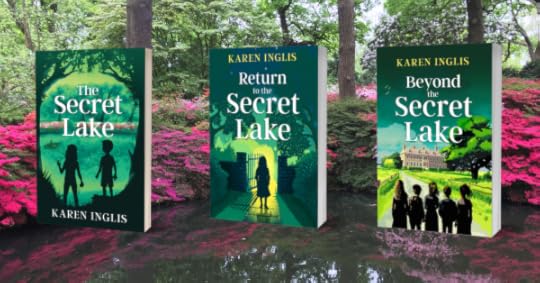 So far, it’s a trilogy – but there are more Secret Lake books to come!
So far, it’s a trilogy – but there are more Secret Lake books to come!Debbie: Karen, you’re a very successful author of children’s fiction, with your bestsellers being your books for middle-grade readers, as they’re known in the trade. What qualities make a story attractive to middle-grade readers? Oh, and what are middle-grade readers exactly?
Karen: Hi, Debbie – thanks for having me! First things first, middle grade refers to books aimed at children aged 8-12. The main characters are generally within that age group, and occasionally a little older. ‘Middle grade’ is a publishing term that has come from America, although I gather from American friends that US parents use the term ‘middle-school books’ rather than middle-grade!
Debbie: Aha! ‘Middle-school’ books makes much more sense to me – ‘middle-grade’ sounds more like a quality judgement!
Karen: I think that what really attracts readers in this age group are stories in which the children have both freedom and agency and are largely away from the adults on some sort of adventure or quest. Not only are they having fun or solving a mystery, but they are also overcoming physical and/or emotional challenges, as well as learning along the way.
That learning might be about themselves or about other people or about life in general – or all three.
Crucially, it is not dictated in any sort of moral way. Rather, as the story progresses, it comes out through the children’s actions and reactions to key events and other characters. Certainly as I write for this age group I can feel both the former child in myself and my future readers imagining themselves alongside the characters in the book sharing their ups and downs. ‘I felt as if I was right there in the story!’ or ‘I wish I could have friends in the past like Tom and Stella!’ is a common comment from my young readers, so I think it’s working! I can’t say I follow a particular recipe for the Secret Lake stories, beyond creating believable (I hope!) characters whom readers will root for, and plots with twists, turns and surprises along the way that keep young readers turning the pages.
In short, the story needs to be one that a child is fully invested in and would want to keep the lights on for way past their bedtime!
Debbie: There are three books so far in the Secret Lake series – how do you make sure each one is different from the others?
Karen: For Return to the Secret Lake (book 2) I was keen from the outset to start from a different angle and to focus on one or two of the characters we had previously met in past time. Thus, whereas in The Secret Lake the story starts in the present, with Stella and Tom discovering the time tunnel and meeting Emma, Sophie, Lucy and Jack back in Edwardian times, in Return to the Secret Lake the story opens in the past (2012), where a life-threatening drama causes Lucy to go forward on her own through the time tunnel to try to get help from Stella and Tom for young Emma who is seriously ill.
So, this time around, I was allowing young readers to see our modern world from Lucy’s perspective whereas in book one the reader had experienced Edwardian London through the eyes of our modern children.
And when later in book 2 they all go back down the time tunnel, rather than have them staying in the homes and communal gardens of Notting Hill, as they do in book 1, a twist in the plot sees them crossing London in an early motor car to meet Jack and his family in East London. Not only did this offer a chance to highlight the sights and sounds of London in 1912, but I was also able to introduce young readers to how the poorer classes lived at that time.
Of course, we writers know well that ‘show, don’t tell’ makes for great writing, and I took care to ensure that the social history was simply there for the taking in the background, with the page-turning plot fraught with danger, twists, and turns taking centre stage.
Finally, in Beyond the Secret Lake (book 3) I went for a ‘hybrid’ approach, starting off in the present once again but very quickly jumping to the past and a ‘parallel’ scene which eventually leads young Jack to come and meet Tom and Stella, only to discover that a letter they have found told them he was coming. (Time moves in mysterious ways!) Once they all return to the past the variety continues as the story takes the children out of London to a grand country estate where all is not as it seems. Needless to say there is a mystery to solve that requires the children’s teamwork, trust and loyalty to each other…
Debbie: In the early 20th century, there was a sea-change in publishers’ and authors’ attitudes to young readers. Out went the cautionary tales about naughty children coming to sticky ends (Struwwelpeter, I’m looking at you!) and moralising stories of perfect paragons. In came adventurous stories of spirited children breaking rules, often in the absence of adults to keep them on the straight and narrow. What innovations and trends have emerged in 21st century children’s books?
Karen: To be honest, when it comes to ‘adventure’ I think it’s much of the same these days – kids are still getting out there and breaking rules, and having fun – but for the most part are working out for themselves what’s right and wrong through their experiences rather than (as might have been the case) a reprimanding adult setting them right at the end!
However, there is a lot more besides – most notably around diversity and ‘being different’ as well as strong female characters – all of which have emerged as strong themes in the 21st century. Children’s book covers today say it all – gone are the dominant images of white middle class characters and in are character casts featuring a blend of children from different ethnic backgrounds, including children with physical disabilities. This is great not just for the story, but also for encouraging the love of reading across the widest possible groups.
Children are far more likely to engage with reading if they can see people like them in the story and we have come a long way on this in recent years.
In addition, themes such as bullying, bereavement, family separation, and being able to express feelings run through many children’s novels these days, along with environmental themes. The Last Bear is a fantastic example of a children’s book that mixes environmental messages with a great story that pulls at the heart with its themes of loneliness and bereavement alongside the effects of global warming, without preaching or moralising . Similarly The Boy at the Back of the Class is a great example of a page-turning story that incorporates not only bullying but immigration, single parent families and the difficulties of fitting in. And there are plenty more where these come from!
Debbie: Although publishers and booksellers categorise and display books as appropriate for a specific age group (not always helpful, because a child’s emotional and reading age don’t necessarily chime), I firmly believe one is never too old to enjoy a children’s book. I’ve recently been rereading E Nesbit‘s books for children, and even at my age I find them compelling and often hilarious. Who are your favourite children’s authors – to read when you were a child, and to read as an adult? Which children’s authors or particular books shaped you as a writer?
Karen: Funnily enough, as a child I didn’t read nearly as much as my siblings did. I spent most of my spare time at the riding stables mucking out and going on adventures riding through woods with my friends! However, my mother did read to us a lot, and it was classics such as Alice in Wonderland, and The Wind in the Willows that really captured my imagination – along with poems from The Book of A Thousand Poems. All of these, I’m sure, have influenced my writing style, particularly for the Secret Lake series. I do, however, remember the magic I felt when first reading The Lion, the Witch and the Wardrobe – especially when the children found their portal into the magical world up in a spare room behind those coats.
This juxtaposition of a magical world that is just out of sight but is there if you look for it is something that has always intrigued me, and I often quote Roald Dhal on that at my school visits:
“…watch with glittering eyes the whole world around you because the greatest secrets are always hidden in the most unlikely places. Those who don’t believe in magic will never find it.” ― Roald Dahl
As an adult, I love reading children’s books, and enjoy a real mix of classics, children’s historical fiction as well as more modern adventures. Notable recent reads have been most of the Anne of Green Gables series which I have absolutely adored (two more to go!), and Journey to the River Sea, by Iva Ibbotson, which had long been on my list!
Debbie: Anne of Green Gables was chosen by our mutual author friend Jean Gill in a previous series of guest posts I ran on this blog in 2020, asking writers to tell us about their favourite school stories. You can read her post here.
Karen: On a more fantastical level, Philip Reeves’ Mortal Engines and Struan Murray’s Orphans of the Tide series are both brilliant reads with feisty female main characters in a Steam Punk world. Ditto Queen of the Warrior Bees by Jean Gill, albeit this is moving into YA.
My love of children’s historical fiction partly comes from falling in love with Jane Austen, Virginia Woolf, and Charles Dickens when I finally really got into reading in my teenage years. These books have definitely influenced my style of writing – or at least my sense of observing the world – in the Secret Lake series.
For my shorter middle-grade novels, which are aimed at more reluctant readers, I think some of the chapter books I used to read to our boys when they were younger including those by Jeremy Strong may have influenced my writing style. Also, I have a business writing background, which requires you to be succinct, and I find it quite easy to switch into that style when crafting a story with a reluctant reader in mind. These books are very different in style to The Secret Lake, which has more description sprinkled into the story.
Debbie: I’m sure any parents, grandparents, carers and teachers reading this would love to hear your top tips for encouraging reluctant young readers to embrace a regular reading habit – what’s your best advice?
Karen: I would say read to your children regularly, and let them see you reading regularly yourself. In other words, lead (or read!) by example. Oh, and let them choose their books (or magazines), no matter what you may think of the author in question! Put them in control.
I believe most young readers prefer print books to ebooks. We all hear so much about children spending too much screen-time.
Debbie: Do adults consciously try to make children avoid ebooks to limit screen-time, or are there other reasons that young readers prefer physical copies? Brough Girling, founder of the charity Readathon – now Read for Good – said “Children see books as toys” – which may also encourage them to choose physical copies that they can touch and hold.
Karen: I honestly don’t know why children prefer print books, but 95% of my book sales are in print! If I had to guess, I’d say it’s nothing to do with being restricted from screen time and more to do with wanting to hold something tangible with the cover on full view, almost as a badge of pride. Long may it continue!
Debbie: Tell us a little about the world of The Secret Lake stories, and what differentiates it from other middle-grade books.
Karen: The books are set in two time periods – Edwardian London from 1911-1913 and ‘modern-day’ London from 2011-2013 with the main characters (Emma and Sophie in the past, and Tom and Stella in modern time) living in the same house.
The overall premise was inspired when some friends moved to a converted apartment in one the huge Victorian houses that backs onto the communal gardens of Notting Hill. When I stepped out on my first visit and saw the children all running freely and playing amongst the trees and clusters of bushes I had one of my ‘tingly moments’ as I wondered what would happen if they could meet the children who had lived and played there 100 years earlier. Then, when I saw one of the children crawl inside a rhododendron bush the notion of a time tunnel was born…
The books are really about friendship and loyalty across time as the children from modern and past time get to know each other and help one another in times of crisis. (It is these crises in turn that seem to trigger the appearance of the time tunnel; there seems to a circular connection bringing the children together.)
The stories have a ‘classic’ feel rooted in historical fiction ‘reality’ rather than a magical world.
The magic is limited to the mysterious moles whose appearance on moonlit nights signals that the time tunnel has appeared inside the rhododendron bush. To this extent I think they differ from much of what’s around – historical mystery adventures, with just a sprinkle of magic!
Debbie: You also write for children of other ages, so whatever age a child is, there will be a Karen Inglis book for them! Can you please tell us a little about your other books?
Karen: It’s by accident rather than design that I write across a range of age groups. It all comes down to my ‘tingly feeling’ as I tell pupils at school visits! This is when I see or hear something that I can’t get out of my mind and feel a shiver run through my body – that feeling refuses to leave me until finally I get around to writing the book, which in some cases can take years! My other titles include two rhyming picture books about kind-hearted Ferdinand Fox for ages 3-5 (inspired by local foxes); a rhyming story The Tell-Me Tree (inspired by a local tree and an overheard conversation) which really helps children aged 4-8 talk about their feelings, and three illustrated chapter books for ages 7-10 aimed at reluctant readers. These last three are fast-paced and fun adventures inspired by local settings or outings with our boys when they were younger. They include Eeek! – featuring a football-mad runaway alien; Henry Haynes and the Great Escape, featuring Gordon, a smelly gorilla with a zoo escape plan, and Walter Brown and the Magician’s Hat, where an inherited top hat and a talking cat cause magical mayhem on Walter’s tenth birthday.

Debbie: Which age do you prefer to write for, and why?
Karen: All of them! I love the variety.
Debbie: What are your top tips for anyone aspiring to write a middle-grade novel??
Karen: Write from the heart, never preach, and before planning your book, read around other children’s middle-grade books to get a feel for what is working. That way, before putting pen to paper, you will be clear about your audience’s needs and in a position to craft the best possible first draft in terms of plot/story, themes, language, characters and book length.
Debbie: What are you writing now? Will there be more Secret Lake books?
Karen: Yes, there will be more Secret Lake books in due course, and I have at least one idea tumbling around in my mind, which is how it always starts… But for the moment I am deep into research for a ‘book for grown-ups’ as I like to say! This one has been in the back of my mind and partially planned (with sample chapters written) for almost twenty years, following a ‘tingly moment’ after something I heard on BBC Radio 4. Whether it ends up coming to something or not I don’t know, but I am thoroughly enjoying going back to the research I started such a long time ago. (The book is set in the future and not the past, so a far cry from historical fiction.)
Debbie: Which children’s classic do you wish you had written? My choice is E Nesbit’s The Railway Children.
Karen: A modern classic I’d have been proud to have written would be Pax by Penny Packer. If going back in time, I’d plump for The Wind in the Willows by Kenneth Grahame.
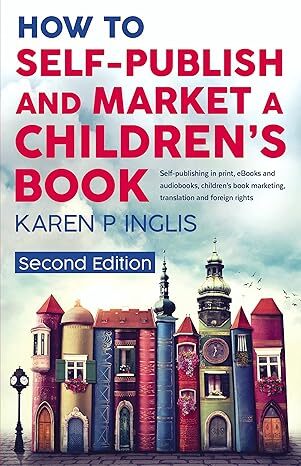 Click image to find out more about this book. (Disclosure: Amazon affiliate link)
Click image to find out more about this book. (Disclosure: Amazon affiliate link)Debbie: Karen, thank you so much for taking time to take in such detail about the world of children’s books and your life as a bestselling children’s author. If anyone would like to find out more about Karen and her work, she has two websites – one for young readers: www.kareninglisauthor.com, and the other for children’s authors, www.selfpublishingadventures.com. She has also written an excellent how-to book for aspiring writers for young readers, How to Self-publish and Market a Children’s Book.
August 16, 2024
Power to the People
While sitting up late awaiting the election results, this hackneyed one-liner kept taunting me: “Whoever you vote for, the government always gets in”. That is, until I came up with a more reassuring version: “In a democracy, whoever you vote for, the people get in”. That’s all very well if you live in a nation where most people are kind, honest, decent, and peaceful. Fortunately, three recent acts of kindness confirmed my belief in the essential goodness of the general British public.
When on a day out in Bath, I tripped over a crooked paving stone and landed flat on my face, people came rushing to my aid from all directions. One lady quizzed me to make sure my fall was not precipitated by a blackout or stroke. Another produced a handful of tissues to mop up the blood streaming from my nose, which had taken the brunt of my fall, (for which my teeth were grateful). Another escorted me to her café for a restorative cup of tea on the house.Boarding a crowded train at Chippenham, I expected to have to stand all the way to London. The previous train had been cancelled due to “animals on the line”. (What kind of animals? I wanted to know.) I was therefore pleasantly surprised when a student from Bath University, according to his tote bag, courteously insisted I take his seat. His manner was so diplomatic that he made me feel I was the one doing him a favour, instead of the other way around.After a hectic, hot day in London, I was waiting at Paddington Station beneath the departures board to learn the platform of my homebound train. A young woman asked me to look after her luggage while she went to get a coffee. Reluctantly I declined, saying I’d have to dash for my train at any moment. When I added that I hoped there’d be a buffet car because I was parched, she laid a hand on my arm with a look of genuine concern that I might be about to keel over, and offered to run and buy me a bottle of water before my train was called. I’m not the only one to have been on the receiving end of human kindness at Paddington Station
I’m not the only one to have been on the receiving end of human kindness at Paddington StationSuch evidence of the general decency of the British public is especially reassuring in times of political uncertainty. It’s also a much more heartening conclusion than the alternative: that I must be looking alarmingly old and frail lately for so many people to be solicitous for my well-being.
I know which I prefer to believe.
This post was written for the August 2024 issue of the Hawkesbury Parish News.
IN OTHER NEWS
 Coming soon! The first in my new Cotswold Curiosity Shop series of cozy mysteries
Coming soon! The first in my new Cotswold Curiosity Shop series of cozy mysteriesOne of the many themes of my novels is encouraging people to be kinder and more understanding towards others. That may sound strange, considering they’re murder mysteries, but they are gentle, feel-good tales at the “cosy” end of the mystery writing spectrum.
This is also true of my new book, Death at the Old Curiosity Shop, which will be launched in all formats on 11th October and is already up for preorder on many platforms, eg Amazon here: https://www.amazon.co.uk/Death-Old-Curiosity-Shop-page-turning-ebook/dp/B0D65KBP1S/. In this first of my new Cotswold Curiosity Shop series, nothing and no-one are quite what they seem. Alice Carroll, the new proprietor of the old bric-a-brac shop, must delve beyond her first impressions to find the truth and solve the curious mystery at the heart of the novel.
The Dickens allusion is intentional, by the way. When you read it, you’ll see I’ve had a bit of fun with allusions to one of the characters in his classic novel, The Old Curiosity Shop. There’s also a surprise in store that will make fans of Dickens’ novel smile.
But you don’t need to be a Dickens fan to enjoy Death at the Old Curiosity Shop! Like all my novels, it’s an easy, quick, lighthearted read, filled with eccentric characters and plenty of humour, sent in an appealing Cotswold village – in this case, Little Pride.
My publisher, Boldwood Books, officially unveiled the cover this week, and I just love it! I’m looking forward to seeing how the branding for this new trilogy develops. I’m already writing the sequel, and all three books will be released in quick succession.
Pre-order the first book now to get ahead of the game!



